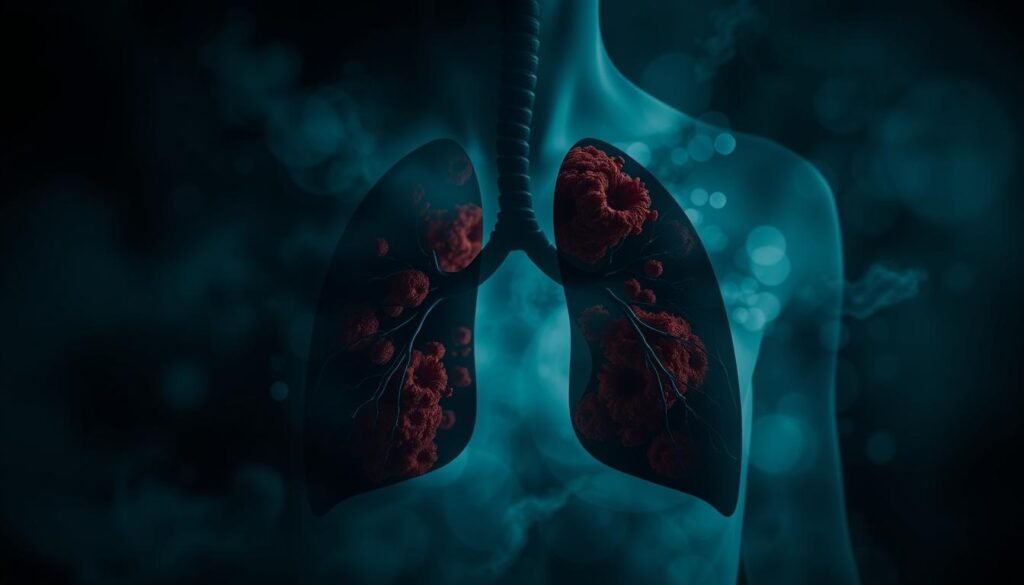Did you know stage 4 lung cancer patients have about a 6% five-year survival rate? This fact highlights why knowing the end stage metastatic lung cancer symptoms is crucial. It helps patients and their families prepare. As cancer advances, it brings complex challenges needing understanding in physical, emotional, and spiritual areas.
This knowledge helps families and caregivers support their loved ones better during tough times. With help from the American Cancer Society and ongoing research, managing terminal lung cancer signs becomes more manageable. For more on handling these changes at life’s end, check out expert resources and guidelines designed for this difficult journey.
Key Takeaways
- Understanding end stage metastatic lung cancer symptoms aids proper care and emotional support.
- Patients may show signs like confusion, extreme weakness, and shortness of breath.
- Managing pain and discomfort well can improve life quality.
- Hospice care provides symptom relief and support, helping families cope.
- Knowing about varying life expectancy in lung cancer helps set realistic expectations.
- Caregiver support services are key to dealing with caregiving stress.
Understanding End Stage Metastatic Lung Cancer
End stage metastatic lung cancer marks a crucial phase where treatment focuses on comfort. At this stage, the cancer has spread throughout the body. The outlook shows severe physical decline and shortened life expectancy, leading to rapid health declines.
About 663,000 Americans are diagnosed with this cancer each year. Many reach this advanced phase. Common symptoms include severe weakness, dependence on others, and needing help with simple tasks. Caregivers help with moving every one to two hours and reduce stress.
Patients often lose their appetite, leading to less eating and nutritional problems. Vision and hearing changes can affect how well patients communicate. Caregivers provide gentle care to ease confusion and restlessness.
The healthcare needs grow quickly, requiring deep knowledge of late-stage complications. For symptom relief, patients may experience:
| Symptom | Description |
|---|---|
| Dry Mouth | Often requires treatments such as lip balm or ice chips to provide comfort. |
| Rattling Sounds | Due to secretions in the throat, usually not uncomfortable for the patient. |
| Circulation Changes | May include cool extremities, skin discoloration, and irregular heart rates. |
| Breathing Changes | Erratic patterns, grunting, and periods of breath-holding are common. |
| Elimination Changes | Darkening urine, decreased output, and loss of control over bladder and bowel functions. |
Death’s reality brings huge stress for families and caregivers. Noticing signs like no breath or pulse is vital. Making a plan for after death, knowing legal steps, and setting financial and health care wishes helps prepare during this tough time.
Common Symptoms of End Stage Metastatic Lung Cancer
In the final stages of lung cancer, people face several warning signs. This shows their condition is getting much worse, fast. Key symptoms of end stage metastatic lung cancer include:
- Persistent cough, which may turn very bothersome.
- Significant weight loss as the body can’t keep up with energy and nutrition needs.
- Extreme fatigue, making it hard to do daily tasks.
- Pain that may be intense because the cancer is spreading.
Shortness of breath is also a major symptom. It often happens because of fluid around the lungs, known as malignant pleural effusion. Recognizing these signs helps families understand their loved one’s serious condition.
As cancer worsens, people change emotionally and mentally. Confusion, anxiety, or pulling away from loved ones may occur. It’s crucial to support patients and their families now. To learn about easing these symptoms, look into end-of-life care.
Shortness of Breath in Lung Cancer Patients
Shortness of breath, or dyspnea, is very troubling for those with advanced lung cancer. This feeling can come from tumors blocking airways, fluid around the lungs, or not enough red blood cells. These issues make it hard to breathe properly.
To manage this shortness of breath, it’s key to know what can help. Procedures like bronchoscopy are noninvasive and can ease breathing problems. Treatments such as surgery or radiation, along with some drugs, might also cause more breathing issues.
There are lifestyle changes that can help with this problem. Here are some tips:
- Quitting smoking and avoiding secondhand smoke
- Staying hydrated
- Practicing deep breathing exercises
- Getting enough rest
- Eating healthy foods
Try breathing techniques like relaxed tummy or pursed lips breathing, and using a handheld fan. These methods can bring comfort and help with breathing. Understanding and addressing shortness of breath in lung cancer can really improve life quality. These steps offer control and hope in dealing with lung cancer’s effects.
Chest Pain and Other Respiratory Issues
As lung cancer advances, patients often face chest pain. This discomfort is due to tumor pressure on nearby tissues. It can lead to significant pain that needs careful attention. Alongside chest pain, individuals might experience persistent coughing and hemoptysis. Hemoptysis means coughing up blood. Both symptoms require medical help to treat their causes and improve the patient’s condition.

It is vital to identify and manage these issues early. Doing so helps enhance the patient’s life quality. Seeing a healthcare provider offers valuable support for chest pain and breathing problems. They can suggest treatments to lessen discomfort and improve well-being.
Palliative care specialists are experts at making patients comfortable. They focus on easing symptoms of advanced lung cancer. This can greatly improve a patient’s quality of life during treatment.
The table below outlines major respiratory challenges in advanced lung cancer. It shows the impact on patients.
| Respiratory Issue | Description | Management Strategies |
|---|---|---|
| Chest Pain | Discomfort due to tumor pressure. | Pain relief medications, physical therapy. |
| Cough | Persistent cough often accompanying lung cancer. | Cough suppressants, hydration, inhalers. |
| Hemoptysis | Coughing up blood, indicating severe complications. | Immediate medical assessment, possible treatment interventions. |
| Shortness of Breath | Difficulty in breathing due to lung involvement. | Oxygen therapy, breathing exercises, bronchodilators. |
Understanding these issues can greatly improve life for those with lung cancer. For more on symptom management and treatment, visit Cleveland Clinic.
Managing Pain and Discomfort
Effective management of pain is very important for those with advanced lung cancer. About 75% of people with cancer feel chronic pain. Lung cancer is the most common kind, with 1.61 million new cases each year. Managing pain is hard because many have severe symptoms when they are diagnosed.
People with lung cancer can have different types of pain. They might feel constant pain for more than 12 hours a day. They also can have sudden, severe pain. Pain can come from the bones, the top part of the lungs, or the chest wall. Doctors need to understand each patient’s pain to help them the best.
The World Health Organization has made a guide for treating pain. It helps doctors decide which painkillers to give, based on Each person’s needs.
Painkillers like opioids are often needed for severe pain. Research shows that people with cancer in their lungs usually need less medicine than those with cancer in their spine. This tells us that treatments need to be chosen for Each person, to help them feel as good as possible.
- Consider palliative procedures to alleviate discomfort.
- Incorporate lifestyle adjustments that may enhance overall well-being.
- Utilize specialized equipment to mitigate symptoms caused by fluid accumulation or other conditions.
- Engage the support of symptom control teams for comprehensive care.
It’s very important to control symptoms well, including pain, for people with lung cancer at the end of life. Working with healthcare teams helps them face this tough time with dignity and support.
Significant Weight Loss and Muscle Wasting
Advanced lung cancer often leads to significant weight loss known as cancer cachexia. It’s not just about losing appetite. Patients also experience muscle wasting, which makes them look very thin. Seeing loved ones go through these changes is tough for friends and family, especially if they can’t eat enough.
This kind of weight loss doesn’t help with energy levels or make life longer. Many patients don’t feel like eating because their bodies can’t process food well. About 80% of advanced cancer patients suffer from some form of cachexia. It’s most common in those with lung or gastrointestinal cancers.

Cancer cachexia leads to loss of muscle and fat, impacting the quality of life and raising healthcare costs. It’s responsible for about 20% of cancer-related deaths. Researchers are looking into treatments like anamorelin. This drug boosts appetite and body weight by imitating ghrelin, an appetite hormone.
Healthcare teams gauge how much weight patients lose and their nutritional needs. They use tools like the Patient-Generated Subjective Global Assessment (PG-SGA). This helps track cancer patients’ nutrition. Dealing with cancer cachexia is key for the care of people with advanced lung cancer.
End Stage Metastatic Lung Cancer Symptoms: Neurological Changes
As metastatic lung cancer gets worse, it can cause serious brain problems. People might experience headaches, seizures, and trouble thinking clearly. These issues can greatly impact their lives, making both medical and emotional support harder for everyone involved.
It’s crucial to notice these brain symptoms early on. This helps in getting the right help quickly. Caregivers need to watch out for these signs, so they can seek mental health support and treatments that ease pain.
Knowing all about end-stage lung cancer symptoms, like brain-related issues, prepares families for the hard times ahead. It helps them handle the disease’s challenges better.
| Neurological Symptoms | Potential Impact |
|---|---|
| Headaches | Can lead to increased discomfort and anxiety. |
| Seizures | Might necessitate emergency medical intervention. |
| Cognitive Impairments | Affects decision-making and communication abilities. |
| Confusion | Impairs understanding of treatment options and end-of-life care. |
By keeping an eye out for these brain-related symptoms, caregivers can better support their loved ones. They can ensure the highest quality of life in this tough time.
Addressing Emotional and Psychological Needs
Patients with end stage metastatic lung cancer face a lot of emotional challenges. They often feel shocked, scared, sad, and worried. These feelings can really affect their lives. It’s important to care for these psychological needs in end stage care with kindness and understanding.
Having support is key. Talking openly with loved ones helps patients share their feelings. Counseling and support groups are also helpful, offering the emotional support these patients need. These resources help reduce loneliness and improve their mental health.

As patients think about life’s big questions, their emotional struggles may grow. They might feel regret and guilt about things left unsaid or undone. Talking honestly with family can offer comfort during these times.
Looking into spiritual matters is also important. Many find peace in reflecting on their life’s journey. Spiritual advisors or counselors provide guidance. They help patients deal with their feelings and find inner peace.
| Emotional Reaction | Description |
|---|---|
| Grief | Intense feelings of loss over anticipated life, physical, and emotional capabilities. |
| Loneliness | Common among patients, exacerbating mental health issues and symptoms. |
| Anxiety and Depression | Prevalent feelings affecting quality of life as patients near the end. |
| Fear | Concerns about suffering, dying alone, and the afterlife often arise. |
| Spiritual Seeking | Finding comfort through spirituality and reflection on one’s life journey. |
Healthcare providers can make a big difference by focusing on these needs. This approach not only helps with the emotional challenges of lung cancer. It also improves the well-being of patients in their last days.
Learn more about why it’s important to deal with the emotional problems of lung cancer patients in this detailed study.
Palliative Care for Lung Cancer Patients
Palliative care helps lung cancer patients live better by meeting their physical, emotional, and psychological needs. It’s helpful at any illness stage and starts conversations about care options early. This care aims to improve life quality for those on their lung cancer journey.
A team of doctors, nurses, social workers, and other professionals work together to support patients. They create a care plan tailored to each person’s needs. They use different treatments to control symptoms, making patients more comfortable.
- Medications for pain relief and nausea
- Oxygen therapy to improve breathing
- Cough management strategies
- Emotional support and counseling
Palliative care can happen in many places:
| Setting | Description |
|---|---|
| Hospitals | Inpatient care with close monitoring by specialists |
| Outpatient Clinics | Regular visits for ongoing symptom management |
| Nursing Homes | Long-term care with palliative support |
| Home | Comfortable environment with at-home care options |
| Specialized Palliative Care Centers | Focused facilities providing comprehensive palliative interventions |
Palliative care helps reduce pain, fatigue, and anxiety for lung cancer patients. Medicare and Medicaid policies often cover it, reducing costs. With many treatments available and a caring team, palliative care is key to improving well-being during the lung cancer journey.
Support for Caregivers during End Stage Care
Taking care of someone with advanced lung cancer is very hard. Caregiver support lung cancer makes sure caregivers have what they need. This is crucial for their own health during such tough times. As the patient’s condition changes, caregivers face new challenges that can feel too big.
It’s common to feel alone when you’re a caregiver. It helps a lot to build a team with family and friends. This teamwork can keep you from burning out. Talking openly about what’s happening can lower stress for you and the person you’re caring for. It’s also important to talk about the patient’s end-of-life wishes early on.
- Professional help may be needed for problems like pain or new symptoms.
- Respite care options can give caregivers a break. This includes help at home or hiring someone to step in.
- Self-care activities like exercise and joining support groups can help caregivers stay strong.
- Using hospice services early on can make a big difference in the patient’s and family’s life.
Most patients with cancer are taken care of at home. This shows why home services and breaks for caregivers are so important. Studies show that patients with this kind of support live better lives. Having the right tools and people to help can make caring at the end of life easier.
Conclusion
Knowing the signs of end stage metastatic lung cancer is key. It helps give patients the loving care they need during tough times. As the cancer grows, the situation gets more complex. This requires more focus on palliative care resources. Such care helps with physical, emotional, and psychological support.
It’s important to understand survival rates. This knowledge helps caregivers and families set realistic expectations and make wise choices. Even though the five-year survival rate for stage 4 non-small cell lung cancer is only 9%, customized care is crucial. Creating treatment plans that meet the specific needs of a person can improve their life quality.
Creating a caring environment is a must. It involves addressing the symptoms of end stage metastatic lung cancer and using palliative care resources. This enables families and healthcare providers to work together well. It ensures every patient’s journey is handled with dignity and comfort during these hard times.